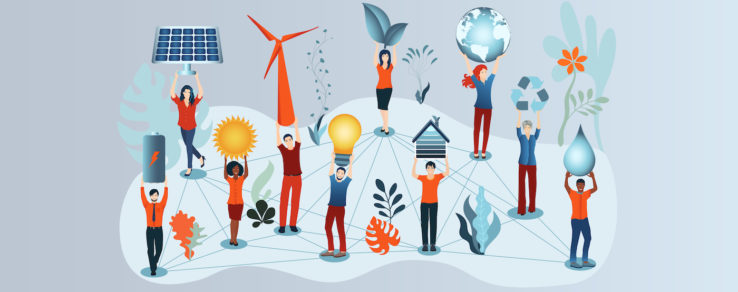The new year is here — and that means new trends for electric utilities to watch in the months ahead. It’s important to stay ahead of these innovations so your energy utility stand out as a trusted resource to customers. To help start the new year right, here are five energy trends for electricity consumption and end-use electric equipment for 2021 and beyond.
1. Electricity Consumption
The Energy Information Administration (EIA) forecasts electricity generation from renewable energy sources, such as solar and wind power, will rise from 17% in 2019 to 22% in 2021. The EIA also forecasts that total U.S. electricity consumed in 2021 will be similar to 2020 consumption. Further, the National Oceanic and Atmospheric Administration (NOAA) forecast of fewer cooling degree days in 2021 will offset an increased demand for space heating.
2. Beneficial Electrification
U.S. renewable energy consumption recently surpassed coal for the first time in over 130 years. Replacing direct fossil fuel use (propane, heating oil, gasoline) with electricity is saving customers money while benefiting the environment. For example, even as beneficial electrification has become more popular, carbon dioxide emissions per MWh from electric power generation has decreased 28% from 2005 to 2018.
Beneficial electrification applications in transportation, space heating, cooking and water heating is improving consumer quality of life and increasing grid resilience. Comparatively, propane and heating oil are twice as expensive as a fuel for space and water heating. Electric vehicles are also saving consumers about $1,000 per year on fuel costs while offering lower maintenance costs, decreased emissions and better acceleration.
3. Lighting Functionality
Fixture efficacy in the range of 200 lumens per watt is becoming more common. With energy efficiency of LED lighting reaching a plateau, the relationship between light and health is receiving even greater emphasis. As a result, the quality of light is replacing efficacy as a major discriminator for lighting specifiers.
The DesignLights Consortium’s (DLC) Networked Lighting Controls program is supporting a major shift toward interconnectivity. Lighting is also serving multiple functions from sound deadening to asset management to wireless internet connectivity to sanitation. Platforms like DALI-2 and PoE++ are enabling software-defined connected lighting that is more flexible and scalable. Lighting as a Service (LaaS) is allowing companies to better focus on their core competencies, rather than on energy infrastructure.
4. Indoor Air Quality
Building owners are realizing the importance of indoor air quality (IAQ) on employee health and productivity. Electric device manufacturers are answering the call. Ultraviolet (UV) light is being used to sanitize and disinfect spaces and mass transit vehicles. Fiber-based air filters are now built with an electrostatic charge and integrated UV lights to achieve better filtration from impingement, charge attraction and UV disinfection.
Plasma generators produce a stream of ions in supply ducts that make microscopic particles clump together and fall out of the air. These ions also enter the conditioned space to kill bacteria and germs before dissipating. Humidity is being removed by desiccant wheels or added using steam, ultrasonic or high-pressure misting systems.
5. Battery Energy Storage
The U.S. energy storage market is set to grow from 1.2 GW in 2020 to nearly 7 GW in 2025, representing sixfold growth. Front-of-the-meter battery storage is helping utilities with frequency regulation, voltage support and black start. Behind-the-meter battery storage is enabling time-of-use bill management, demand charge reduction, increased PV solar self-consumption and backup power resiliency.
Lithium-ion (Li-On) batteries provide higher-capacity storage, longer rated life and lower maintenance costs. Standards like NFPA 855 Installation of Stationary Storage Systems and the 2018 International Fire Code (IFC), Section 1206, have given users guidelines for safer operation of batteries.
Electric utilities: New trends for the new year
Now is the time to prepare for the trends your electric utility’s customers should be focused on in 2021 and beyond. Forecasts about electricity consumption and beneficial electrification can help your utility plan how to market your programs in the new year. Plus, understanding the changes in lighting and indoor air quality is especially important in helping customers push through the coronavirus pandemic and return to a “new normal.” A lot is in store for electric energy use this year — is your energy utility ready?

